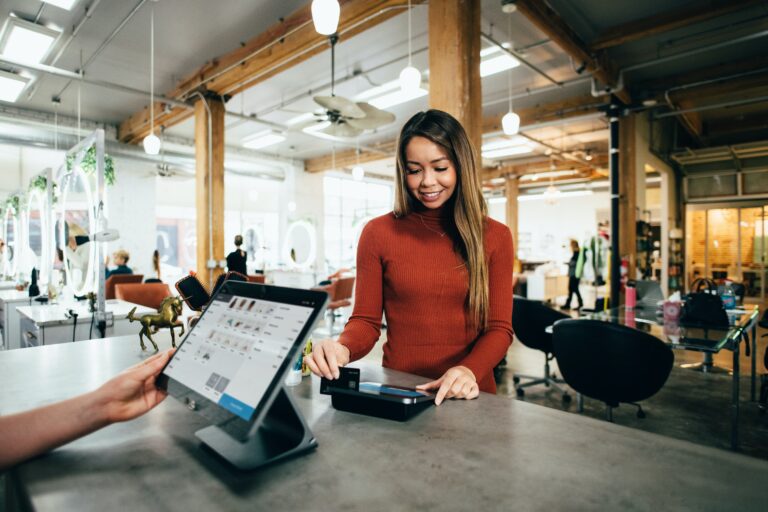By Tim Matthews, Senior B2B Product manager, Vestel
The COVID-19 pandemic has impacted the retail sector tremendously, with one of the most significant effects being a major slump in footfall which in turn has cast doubts over the future of the physical store. The BRC reported that footfall in June was down year-on-year by 62.6 per cent, recovering to a still considerable deficit of 42 per cent in July. In turn, many consumers have turned to online shopping from the safety of their own home, with the ONS attributing 31.8 per cent of June’s retail sales to the internet – up from pre-COVID figures of 20 per cent, reported in February.
Yet despite these trends, Amazon announced the welcome news earlier this month that it plans to open at least 30 physical, cashierless shops in the UK – a move which suggests the pandemic hasn’t sounded the death knell for the bricks and mortar store just yet. Rather, it offers hope at a time when retailers continue to grapple with a new normal, aiming to strike the balance between ensuring customers and staff are safe while maintaining customer experience levels. What is evident is that the increased presence of technology could play a key role in helping to shape and ensure the future of the retail store, both during the pandemic and beyond.
Digital signage and displays
In the current circumstances, retailers have a duty to inform customers of social distancing requirements, as well as enforce the guidelines across their premises. The introduction of digital signage to stores can help to both remind shoppers of the latest government instructions, as well as signpost the direction of traffic to ensure people are navigating through the store in a safe one-way system. Such screens can also be updated in real-time and remotely, reducing human touch points and eliminating the resources required to replace paper signage.

Further to displays located in-store, digital signage can also be used within shop windows to provide information for those outside of the shop. This can prove useful when managing queues – increasingly common nowadays, and often a source of frustration for customers who may take their business elsewhere as a result. Digital signage within windows can help to provide greater transparency to these customers, not only being used to showcase in-store promotions, but also to provide real-time information on approximate wait times, how many people are currently in the store versus its maximum capacity, and expected quieter periods. Armed with such information, shoppers can plan their day better and know when it might make sense to come back at another time.
Larger retailers could even install in-store sensors which communicate with these screens, enabling greater accuracy of footfall reporting, while content management systems (CMS) can pull live data by integrating with cameras, for example, which can provide automated counting – removing the need for door staff to manage this process. Such solutions also deliver a wealth of insightful footfall-related data to retailers which can of course be used to inform marketing strategies.
Kiosks and dispensers
As well as digital signage, retailers should also consider solutions such as kiosks and sanitiser dispensers to support with health and safety measures, while at the same time enabling the transition towards a more tech-centric future. While the Amazon approach of removing all cashiers won’t be feasible for most businesses, increasing the number of self-service kiosks would help to quicken the speed at which customers purchase their items, subsequently minimising queue times outside and increasing the amount of potential business that can be conducted throughout the day. Kiosks also provide safety benefits for staff and customers by reducing human-to-human interaction – something which can be heightened further if they feature voice-activation too. For example, vision AI software from companies like Sodaclick delivers voice-activated, interactive, digital signage solutions to support self-service kiosks. By deploying machine learning, multilingual neural net speech recognition and vision detection, Sodaclick’s Voice solution provides an immersive and hands-free experience which at the same time helps to ensure the well-being of customers.
Additionally, hand sanitiser displays are growing in prominence, used to broadcast health and safety reminders, as well as provide shoppers with the opportunity to use antibacterial hand gel via the in-built dispenser, thereby reducing the spread of germs across the shop. Retailers can also hook these up to a CMS to again track usage levels and keep themselves informed of when various stations need refilling.
A tech-first retail future
There is a clear need for such technologies to be implemented across retail environments at this time to support health and safety. Yet the increased focus on digital solutions in this regard could also serve as the catalyst for retailers to think more broadly about the role of technology in their stores from an experiential perspective – especially as they look to compete against the likes of Amazon moving to the high street. The more consumers become accustomed to these high-tech environments, the more necessary it will be for retailers to rethink their physical space.
LED video walls could be adopted to enhance the customer experience through storytelling and animation, for example, while more experiential retailers may go a step further and consider technologies which can deliver immersive or virtual experiences. While the traditional physical store as we know it may not have a long-term future, it is abundantly clear that there is still very much a space for the high street and when it does bounce back, it may be in a much more innovative and engaging way than ever before – sparking a bright future for the physical store.
About the author
 Tim Matthews is Senior B2B Product manager at Vestel, the hardware giant and one of the largest TV, display and digital signage manufacturers in the world. Tim has over 20 years’ experience in the AV sector previously working as a Product Manager at Toshiba.
Tim Matthews is Senior B2B Product manager at Vestel, the hardware giant and one of the largest TV, display and digital signage manufacturers in the world. Tim has over 20 years’ experience in the AV sector previously working as a Product Manager at Toshiba.
Related Articles

The Rise of Digital Experience Platforms (DXPs) in Software Development
Software development is evolving, as Digital Experience Platforms enable the delivery of a personalised digital cross-channel experience. A DXP delivers integrated content, Artificial Intelligence, and low-code rapid application development tools. It streamlines the work of developers as well as marketers.

7 Employee Benefits That Can Help Your Business Increase Staff Retention
With so many businesses vying for the attention of skilled job candidates, it’s becoming more important to look for ways to make your offerings more appealing by adding unique perks that not every employer does.

How Retailers Can Prepare for the Summer 2025 Shift
Rather than focusing on isolated touchpoints or departmental KPIs, journey management provides a way to understand where the most critical pain points lie and how to resolve them systematically across the business.

Retailers Are Drowning in Data – Journey Management Could Be the Lifeline
Rather than focusing on isolated touchpoints or departmental KPIs, journey management provides a way to understand where the most critical pain points lie and how to resolve them systematically across the business.



 for the latest news and job opportunities in retail tech
for the latest news and job opportunities in retail tech 